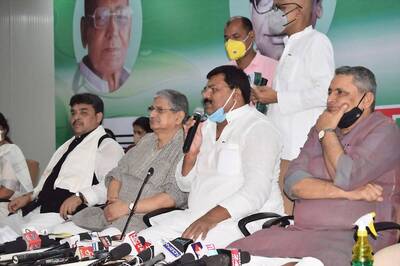
views
Removing Spark Plugs
Disconnect the negative terminal on the battery. Locate the battery either in your engine bay or in the trunk. It will look like a black plastic box with 2 metal terminals sticking out of the top. Find the negative terminal, which will be marked with a (-) minus sign. Loosen the bolt holding the cable on the terminal and then slide it off. If you can’t find your battery, refer to the vehicle’s owner’s manual or the manufacturer’s website. Tuck the cable to the side so it doesn’t accidentally come back into contact with the battery terminal.
Locate the spark plugs. Find the spark plug wires (thick cables running from the ignition coils to the top of the engine) where they connect to the spark plugs and follow them to the openings in the cylinder head for each. There will be 1 cable and 1 plug for each cylinder in your engine, so a V6 will have 6, whereas a two-stroke dirt bike will only have 1. If you’re having trouble locating the spark plugs on your particular vehicle, refer to the owner’s manual or a vehicle specific repair manual for help.
Use a can of compressed air to blow debris away from the spark plugs. Once you’ve found where the spark plugs are screwed in, you’ll need to clean all the dirt and junk out of the area to stop any of it from falling into the cylinders while the spark plugs are removed. Use the compressed air to blow all loose materials safely away. If any dirt or debris falls into the cylinder while the spark plug is removed, it could cause serious damage to the engine. Always wear eye protection when using canned air to spray away debris.
Disconnect the spark plug wire on 1 spark plug at a time. In order to keep the cables organized and minimize the risk of debris falling into the cylinders, you should clean the spark plugs 1 at a time. Removing all of the spark plugs at once could make it easy to confuse which cable goes to which cylinder, and would also increase the chances of something falling into the empty holes the spark plugs used to fill. Grip the spark plug cable firmly, low on the boot nearest to the spark plug, and then pull it away and off the plug. Don’t pull from high on the wire or you could separate the inside of the cable from its connector for the plug. If the wire is really stuck, trying twisting it a little to loosen it up, then pull.
Use a spark plug socket to unscrew the spark plug. Place the spark plug socket on the end of an extension and then connect it to your ratchet. Put the socket over the spark plug and turn it in a counter-clockwise direction to unscrew the plug from where it’s seated. Once it’s loose, pop the extension and socket off of the wrench and finish unscrewing it by hand. There’s a rubber grommet inside the spark plug socket that will keep the plug in the socket as you remove it from the engine. Look around one more time for any loose dirt or debris before pulling the spark plug out. If you spot some, blow or brush it away.
Cleaning with Abrasives
Use 220-grit sandpaper on the electrode. At the end of the spark plug (on the side that goes into the engine) you’ll find a small piece of metal extending out of the plug. That’s called the electrode. If it is black or discolored, slide the sandpaper beneath the bent over portion of the electrode between it and the plug itself and run it back and forth until you see clean metal on either side. The spark plug electrode should look like bare metal. If it doesn’t, keep sanding until it does. Always wear eye protection and a mask when sanding.
File down the grime on the electrode if it’s particularly dirty. If sandpaper doesn’t do the trick, the spark plug really should be replaced, however, in a bind you can use a small file to grind away significant carbon build up on the electrode. Slide the file into the gap between the plug and the electrode and then move it back and forth to clean the metal.
Scrub the threads with a wire brush. Chances are good that there’s a build up of oil and grime in the threads of your spark plug, which will make re-installing them difficult. Scrub at the threads with your wire brush from a perpendicular angle to the plug (so the brush is moving in the same direction as the plug’s threads) to remove the majority of the built-up gunk. Then switch and scrub it from other angles for maximum effect. Wear gloves while you do this to avoid poking yourself with the wire brush. The threads don’t need to be perfectly clean to work, but should be free of most buildup.
Spray brake cleaner on the plug and wipe it down. Brake cleaner is sold in spray cans at your local auto parts store and can be used to effectively clean grime off of many car parts. Aside from cleaning, it evaporates rapidly so the parts dry quickly. Spray some brake cleaner on the plug and threads, then use a clean rag to wipe away any remaining dirt or debris. If your spark plugs are really dirty, you can use the brake cleaner and wire brush together to tackle stuck on grime. Make sure to wipe the plug down thoroughly with the rag after to remove all of the brake cleaner that has soaked up dirt and oil.
Repeat the process for each spark plug. Once that first spark plug is clean, reinstall it and reconnect the spark plug wire that goes to it. Then repeat the process with each spark plug until they have all been cleaned and reinstalled.
Using a Blow Torch
Grip the spark with pliers on the end the wire connects to. Because the torch will get extremely hot, you’ll need the extra length the pliers provide to keep your hand safely away from the heat. Keep a firm grip on the plug, but don’t squeeze so hard that you risk damaging the spark plug. It only needs to sit in the pliers as a handle extension. If you have a bench vice, that will work in place of pliers.
Put on gloves and ignite your torch. Turn the knob on your gas or propane torch to allow gas to flow, then either hit the ignition button or place an ignition source in front of the nozzle. The torch will then light up and begin burning. You may choose to wear gloves just to give your hands a bit more heat protection. Turn the torch all the way up so it is producing a blue flame.
Hold the end of the spark plug in the flame until it turns red. The torch will burn the carbon and debris off of the spark plug, and because the plug is designed to be inside the engine when it ignites, it will survive the heat without issue. Hold the plug in the flame, rotating it from side to side, until the end of the plug and the electrode are glowing red hot. Depending on how hot your torch is, this may take several minutes. Be extremely careful not to allow the flame from the torch to reach anything else in your work area.
Let the plug cool and do not touch it with your fingers. After the plug gets hot enough to burn away the carbon, it will need to cool for a few minutes before you can work with it. Be extremely careful; the spark plug will return to normal colors long before it is cool enough to touch. To be safe, give each plug at least 5 minutes to cool before attempting to reinstall it. Once the spark plug is cool, it will be clean enough to reinstall.
Repeat the process for each spark plug. Once the spark plug is cool enough to reinstall, put it back in, reconnect the spark plug wire, and move on to the next spark plug. Continue to repeat these steps for each plug until they are all clean. It is important that you clean each spark plug so that some cylinders don’t burn more efficiently than others.
Reinstalling the Clean Spark Plugs
Use a gap tool to correct the gap between the plug and the electrode. Check your vehicle’s owner or service manual to find the exact gap measurement for your spark plugs in millimeters. Then, insert a gap tool into the space between the spark plug’s body and the electrode that sticks out of it. Use the tool to measure the gap, then either pry the electrode further from the body to increase the gap or press it closer to the body to decrease it until the gap matches the vehicle’s specifications. You should be able to press the electrode out or squeeze it closer to the body simply by applying pressure on it using the gap tool. You can purchase a spark plug “gapper” or gap tool at any auto parts store. If you are unable to find the gap specifications for your vehicle, try the manufacturer’s website.
Place the plug in the spark plug socket with the threads facing out. The spark plug socket has a rubber grommet that will hold the plug in place as you lower it down into the engine and make it easier to thread the plug once you have it in there. The threaded portion of the spark plug is the same end as the electrode. That end should be sticking out of the spark plug socket.
Insert the spark plug and turn it clockwise to seat it by hand. It’s important that you don’t cross-thread your spark plugs, which occurs when you forcefully tighten it even though it hasn’t seated properly in the engine. To avoid this, tighten the spark plug by hand using an extension connected to the spark plug socket. Keep screwing the spark plug in until it becomes snug. If the spark plug seems to be screwing in on an angle, unscrew it, pull it out, and start again so it seats evenly.
Tighten the spark plug using a socket wrench. Once the spark plug is snugly seated in place, connect a ratchet to the extension and finish tightening it. Make sure the spark plug is secure, but you don’t have to put too much force on it through the wrench. Over-tightening the spark plug could cause it to break inside the engine, so only apply enough pressure to ensure the spark plug is secure.
Reconnect the plug wire to the spark plug. Grip the plug wire by the boot near the end and press it firmly down onto the exposed end of the spark plug sticking out of the engine. You will hear an audible pop when the plug wire is firmly connected. If the wire doesn’t seat perfectly at first, twist it to the left and right as you press it down to help it pop into place. If you don’t hear it click or pop, the plug wire isn’t connected firmly enough yet and could pop off while driving.




















Comments
0 comment